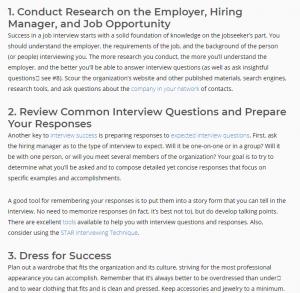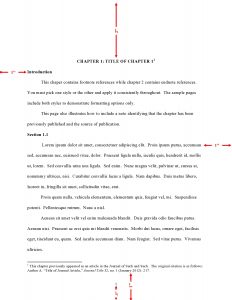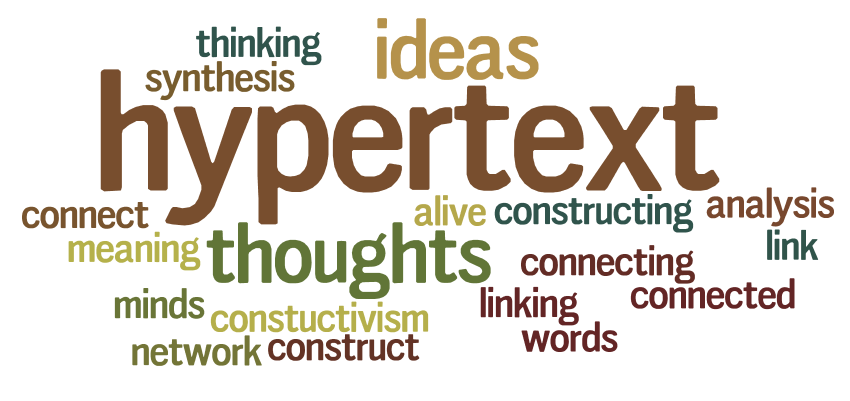I believe that hypertext is important in our understanding and reading of different texts. Vicky stated in her post that, “while hypertext does not change the physical words on the page, it does impact the order in which they are read. This allows for an infinite number of reader interpretations….” I think this is very true. With hypertext, you can begin reading one text, be taken to another text which you can read all the way through, and then go back to exactly where you left off in the original text, or you can get so distracted by clicking on new hypertext links in the new texts that you completely forget about the original text altogether. This creates new meanings and adds to the meaning of the original text.
I recently encountered an example of how hypertext changes the meaning of a text, in both positive and negative ways, this week. In preparation for a job interview, I wanted to Google some tips on interview preparation. I first clicked on a link detailing the “10 Best Job Interview Tips” from livecareer.com. The second out of the ten tips told job seekers that it’s extremely important to research potential interview questions and plan out detailed responses. I had no idea what to expect in terms of what questions I would be asked, so I clicked on the hyperlink that they provided, which took me to another page on their website. I thoroughly browsed through this page and recorded my response to the interview questions they provided before clicking back to the original page. Now I had more knowledge which would help me with the interview, as well as with understanding the rest of the article.

Through this search, I can better appreciate Barnet’s and Tofts’ understanding of hypertext in their text “Too Dimensional.” They state that “all our ideas have basic interconnections, and this is what enables the creation of new concepts as well as recall.” The interview tips were mostly recall for me, as I already knew that you should be early to interviews and make a good personal first impression, but the hyperlinks also provided me with new concepts, as I was unaware what questions interviewers typically ask in a professional field. I think this is a benefit of hypertext; that it enables users to learn new information, even beyond what is written on a given page. A related benefit of hyperlinks is that the information is right at the user’s fingertips so that they don’t have to do a separate search on a given concept; it is, as Christian Vandendorpe points out in “Reading on Screen,” is “apt to be thought of as a purely logical structure.” However, a potential drawback of hypertext is that, as Sarah said in her post, “people have been known to spend hours following hypertext links down increasingly divergent paths, ending up in a completely different place from where they started.” A user can become so distracted by hyperlinks that they forget their original task.
While I used to think, like Jordyn, that hypertext is “excluded to digital writing,” Barnet and Tofts say that hypertext “is an organizational form which may just as readily be delivered on paper as electronically” (“Too Dimensional”). This made me think of academic papers, particularly in Chicago style, where citations are marked with a superscript number, and a matching number appears with the full citation at the bottom of the page or on a separate page. I think this is an effective example of hypertext, as it is organized to take users for a short time to a different part of the page.

I think the most interesting thing about hypertext is the potential it has for digital storytelling. In “Too Dimensional,” Barnet and Tofts discuss the ways in which fiction can be rewritten in ways we haven’t thought possible. They use James Joyce’s Ulysses as an example in which every word of the book can be turned into hypertext, and “the perception of an apparently endless process of linking through, between, and within this dense palimpsestual Ulysses crystallized the new aesthetics of interactive, arguous reading associated with hypertext.” I have never read any work of fiction that utilized hypertext, but I am very interested in seeing where fiction writers, particularly on digital writing environments such as fanfiction sites, take hypertextual media in the future.
Word Count: 727
Works Cited:
Barnet, Belinda, and Darren Tofts. “Too Dimensional: Literary and Technical Images of Potentiality in the History of Hypertext.” A Companion to Digital Literary Studies, www.digitalhumanities.org/companion/view?docId=blackwell/9781405148641/9781405148641.xml&chunk.id=ss1-5-9&toc.depth=1&toc.id=ss1-5-9&brand=9781405148641_brand. Web. 14 Apr. 2018.
Hansen, Randall S. “10 Best Job Interview Tips for Jobseekers.” LiveCareer, LiveCareer, https://www.livecareer.com/career/advice/interview/job-interview-tips. Web. 14 Apr. 2018.
Vandendorpe, Christian. “Reading on Screen: The New Media Sphere.” A Companion to Digital Literary Studies, http://digitalhumanities.org/companion/view?docId=blackwell/9781405148641/9781405148641.xml&chunk.id=ss1-5-4&toc.id=0&brand=9781405148641_brand. Web. 14 Apr. 2018.
